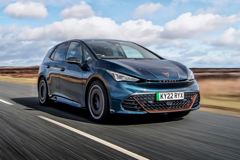DS No4 E-Tense Review 2026
DS No4 E-Tense At A Glance
In the spheres of luxury fashion, fragrance and cuisine, French brands are synonymous with excellence, yet despite numerous attempts as a nation, it’s almost always fallen short when it comes to upmarket cars. The latest contender to attempt to break the cycle is the DS No4 E-Tense.
Since its divorce from Citroen a decade ago in the pursuit of reinventing itself as a standalone brand, DS has struggled to sell its significant numbers of its premium-priced cars since the original DS 3 went off sale. While its new No4 won’t trouble the tops of any sales charts parent company Stellantis will hope it proves more tempting than the outgoing DS 4.
A fully electric drive system is one of the crucial aspects hopes are being pinned upon with the DS No4 E-Tense. It’s the single biggest change ushered in as part of the old 4’s mid-life makeover — unlike the larger DS No8, this isn’t an all-new model — meaning the E-Tense EV versions will sell alongside mild and plug-in hybrid DS No4 models we’ll cover separately. DS has bid au revoir to the diesel, though.
DS will be keen to swiftly clarify in its impending marketing campaign how to say the facelifted car’s name. Rest assured it isn’t a negative ‘No! 4’, rather an abbreviation of the French numéro in a manner similar to that used by Chanel for its perfumes. And just as its perfectly acceptable in English to say ‘Chanel Number 5’, it will be verbally known here as the ‘DS Number 4 E-Tense’.
Name and drive system aside, given it’s a refresh, not box-fresh, what’s new about the DS No4 E-Tense? Surprisingly little based upon its exterior, where all of the expensive to produce body pressings are carried over, save for the slightly longer bonnet.
It crowns a redesigned bumper moulding where the incorporated grille has been exchanged for something reminiscent of the No8’s, although the No4 E-Tense does without its glazed panel aesthetic. Instead, a punctuated lightning flash of LED daytime-running lights are linked in the centre of the nose by an illuminated DS logo.
Cleaner, contemporary and less chromed, related touches appear elsewhere around the DS No4 E-Tense, with darker-tinted jewel-like tail lights, greater amounts of gloss black fixtures and fittings and a far bolder DS Automobiles script across the tailgate.
Given the model it replaces was strikingly styled, the modest scope of the alterations isn’t a negative development. It’s not without irony that given its rarity on UK roads, few will notice how subtle the degree of change really is.
It’s a similar story inside the DS No4 E-Tense where many of the revised elements relate to upholstery and trim panel textures and colourways. Rather cleverly, DS has inserted a slightly enlarged 10.25-inch driver display screen, complete with new skins for it and the multimedia interface, into the same dashboard moulding as before. No sign of the No8’s X-shaped steering wheel spokes in here, though.
Propelling the DS No4 E-Tense is a front-mounted electric motor coupled with a single-speed transmission that’s essentially operated in the same manner as a conventional automatic gearbox.
It’s the same arrangement fitted to the closely related Peugeot E-408, although DS hasn’t published any performance figures so far for the No4 E-Tense. What we do know is that power’s quoted at 213PS with torque peaking at 343Nm.
Storing the electrical energy is a sub-floor 58.3kWh battery which allows the most efficient DS No4 E-Tense models to achieve a WLTP Combined cycle range of 279 miles. AC charging can be at flow rates of up to 11kW with DC rapid charging at a high of 120kW, the latter enabling a 20-80% charge replenishment in as little as 30 minutes. Using a typical 7.4kW domestic wallbox the same recharge takes 4 hours 25 minutes.
Many rival models of a similar battery size fall slightly short of the No4 E-Tense’s range figure — a best of 264 miles is quoted for the Curpra Born when fitted with the 59kWh battery, the 63kWh Hyundai Ioniq 5 is rated at 273 miles, although up to 280 miles are eked from the Renault Megane E-Tech’s 60kWh pack.
Three levels of specification are available for the DS No4 E-Tense — Pallas, Pallas+ and Etoile. All models are fitted as standard with LED head and tail lights, electrically adjustable, heated and folding door mirrors, adaptive cruise control, front and rear parking sensors, a reversing camera and laminated front side windows for a quieter driving experience.
Highlights of upgrading to the Pallas+ grade include keyless entry and starting, a heat pump to boost the efficiency of the high-voltage battery pack, the customisable DS Iris multimedia system with 3D connected navigation plus a wireless smartphone charging pad.
Additional snazziness incorporated into DS No4 E-Tense Etoile versions include adaptive Matrix LED headlights, laminated and dark-tinted rear passenger windows, Alcantara faux suede upholstery that’s also extended to door panels and dashboard, a windscreen-projected head-up display and electrically adjustable front seats. Note that the Etoile’s driving range is one mile lower than the other models at 278 miles
Orders for the DS No4 E-Tense opened in August 2025 with the first customer deliveries due towards the end of the year. Due to the entry-level Pallas version’s starting price being £36,995 all No4 E-Tense models are potentially eligible for the government’s Electric Car Grant (ECG) discount — we expect confirmation soon that the DS will fall into Band 2 and result in £1500 being lopped-off, lowering the price to £35,495.
For the time being, the DS No4 E-Tense Pallas+ costs £39,160 with the Etoile coming in at £41,860. If the ECG Band 2 discount is confirmed those prices will become £37,660 and £40,360 respectively.
Keep this page bookmarked as it will be updated with further news on this model as well as our comprehensive full DS No4 E-Tense review in the coming weeks.
Model History
May 2025
DS4 becomes DS No4 as part of major update
The DS4 has become the DS No4, following the brand's new naming convention brought in with the larger DS No8 EV. Unlike the No8, the No4 isn't an all-new car, but a major update of the outgoing DS4.
Aside from the new name, the major change is the addition of an electric version of the No4 for the first time. The EV has a 213PS motor and 58.3kWh (net) battery, giving a range of up to 280 miles.
As before, there's the option of a 225PS No4 plug-in hybrid, now with a 14.6kWh battery, giving up to 50 miles of range, or 30% more than the DS4. A 145PS hybrid is also offered.
The design has been overhauled inside and out to bring it in line with the look of the No8. New light designs feature, as does a 12mm longer bonnet. 19-inch alloys are standard, with 20-inch rims an option. On the inside, there's now a 10.25-inch digital instrument cluster, plus uprated infotainment.
The No4 will be available in Pallas and Etoile trims and goes on sale later this year, with first deliveries in early 2026.







 Longer driving ranges than many rivals. Still looks distinctive among family-sized hatchbacks. Decent equipment levels for the money.
Longer driving ranges than many rivals. Still looks distinctive among family-sized hatchbacks. Decent equipment levels for the money.
 Flies in the face of SUVs’ growing popularity. Will UK customers finally embrace this upmarket French brand?
Flies in the face of SUVs’ growing popularity. Will UK customers finally embrace this upmarket French brand?




